Explanation of how I effectively increased traffic to a brand new website without using any hacks or tricks.

You require more visitors.
More people who visit your website leads to more impressions, more signups, more purchases — more revenue.
But how can you get more visitors from search results that are growing more crowded, diversified, and changing in the way they are delivered?
Obviously, with SEO
Today, I’d like to discuss a technique that we’ve established at Siege Media for gaining links, web visibility, and increasing web traffic for our clients. I’ll show you how I built a site’s SEO strategy from zero to 100,000 visitors — and offer important takeaways that you can use in your own strategy.

The following was the broad outline of our strategy:
- Begin slowly & benefit from “easy wins”
- Concentrate on obtaining a handful of strategic connections to essential connections
- To build momentum by establishing passive link acquisition channels
- Make content creation and its impact on search a priority
- Level up over time, and target higher-value opportunities
Let’s get started with the case study:
As we had complete control over the website, it was much easy to correctly credit the organic gains to the SEO work we were doing and also to offer SEO recommendations along the way. To maintain the website’s confidentiality, I’ve additionally anonymized the data.
- With a new site, start slowly
We knew there would be restrictions, starting with a fresh site.
At first, we concentrated on opportunities with little competition and a high traffic value. We utilized Semrush to estimate the worth of traffic and manual research to identify competitors.
We looked for results using the following keywords in the search engine results pages (SERPs):
- Bad exact-match domains
- Insufficient big name brands
- Poor & low quality or outdated content
- Low link count pages
For [life insurance quotes in California], here’s an example of this sort of SERP:

Although several well-known brands rank (State Farm and GEICO), there is also a poor exact-match domain result:
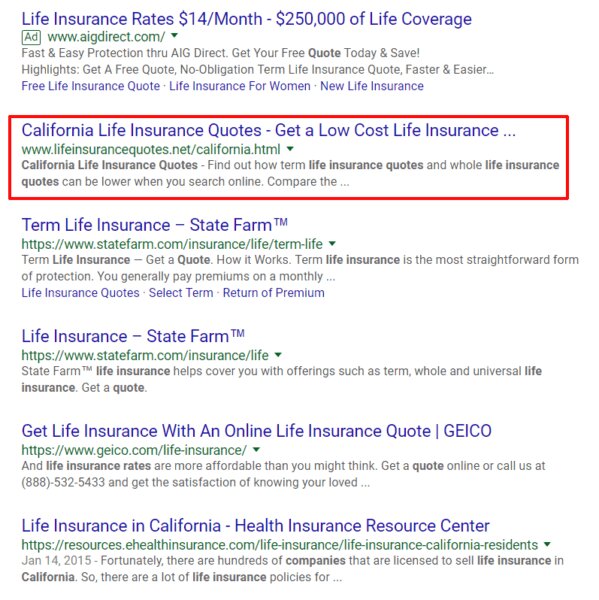
When you click on this link, you’ll see that the content is of poor quality:

In the SERP, there are also some bad results:
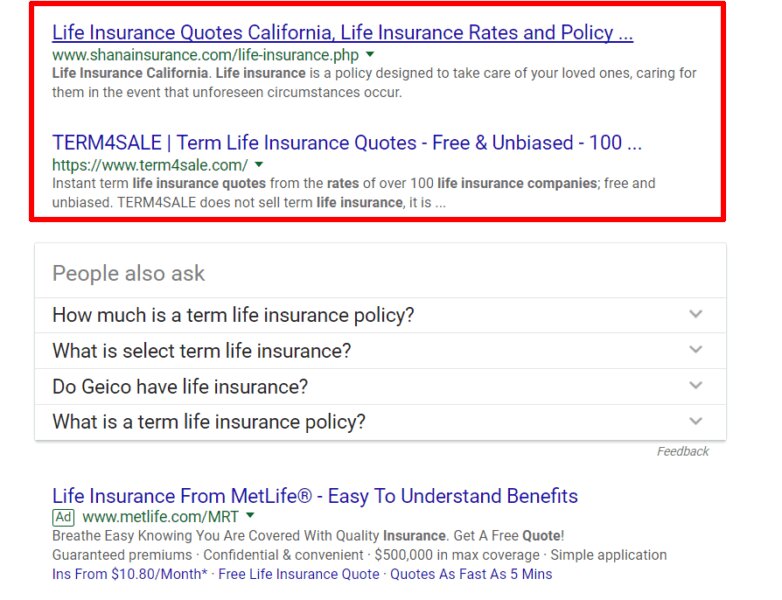
Finding results with these sorts of pages would encourage us that we could easily create something that searchers would choose.
After identifying the possible opportunities, we create the best-in-class content to target those particular SERPs. To differentiate our content from others in the space we made use of:
- Custom created graphics
- Clear, engaging & concise copy
- Unique & original photography
- Font size, column width, scannable text, and so on should all be optimized.
By creating content that satisfies the user’s intent & query, we set our pages up to be successful in SERPs.
- Obtaining a small number of key page connections
The links of the pages are required to rank in the search results. The amount of links required to be competitive, however, varies by page, site, niche, query type, and so on. In addition, search engines have improved their link evaluation algorithms, putting a greater focus on quality rather than quantity.
What we gained by working on this project was that bottom-of-the-funnel pages just require a few high-quality links to rank high and that positive interaction signals will help search engines recognize the page as an authority.
Obtaining connections to bottom-of-the-funnel pages is, of course, extremely hard because these pages are rarely link-worthy. These pages aren’t meant to inform or entertain; they’re meant to generate conversions, which doesn’t always encourage other sites to connect to them.
There are a few situations where providing direct value to your site matches with the aims of other websites, and link opportunities exist. Hyper-focused link pages that are related to your content are included in these chances.
Using the same insurance example, this page would be a hyper-relevant links page for a pet insurance company:

Because of the limitations of some situations, this technique isn’t viable for a long-term, large-scale campaign.
However, we discovered that in order to be successful with bottom-of-the-funnel pages, you only need to execute on a select handful of these opportunities.
Opportunities that are available to Bottom-of-the-funnel-pages consists of:
egobait – a certain person, brand, product, or service is mentioned on your page, for example.
Unique product/ service- resource pages that list the small number of vendors available
Discounts or promotions — the linking site’s audience is eligible for exclusive discounts.
Local — resource pages that are only available to vendors and service providers.
Reviews — Pages that provide feedback on your product or service
With these techniques, you won’t be able to establish a long-term link acquisition campaign, but you will be able to gain a few quality links to your converting pages and increase your site’s initial engagement.
- Create acquisition channels for passive links
Link building is a task!
Link acquisition is a never-ending process. Former Googler Matt Cutts characterized link building as “sweat plus creativity,” which is also my favorite definition. We tried to develop passive link acquisition channels to amplify all our link-building efforts since acquiring connections is so tough — yet we knew we needed links to boost traffic.
We used high-quality, unique photographs as part of our content strategy, and this gave a great chance to gain passive links. Instead of copyrighting or watermarking our photographs, we chose a Creative Commons license that enabled anyone to use them as long as they credited the utilizing traffic increases source (on our site).
For example, in the screenshot below, Ars Technica is citing the photo they used for their article.
Even large publications like these require excellent photography, which they frequently obtain from Creative Commons or other places.
Other organic techniques to gain links, in addition to having your photos cited, include:
- Sponsorships and participation in the community
- Assembling original data or doing research
- Interviewing or getting quoted
- building a unique tool
The idea is to come up with something unique and then make it simple for others to reference (link to) you as the source.
- Creating strategic content
Content drives SEO success.
It’s possible to gain a few connections to bottom-of-the-funnel pages but to sustainably attract attention and links, you’ll need middle and top-of-the-funnel content.
It’s always a good idea to create useful content for your audience, but you can take it a step further by being deliberate and smart about what you share. We maintained a relentless focus on SEO — creating every page with search, and the opportunities available to us, in mind.
To calculate the opportunity, we compared Semrush traffic value against the utilizing competition level.
We may examine potential opportunities using the example of “pet insurance.” This site, for example, is ranked first and is estimated to be worth $31.2K by Semrush:
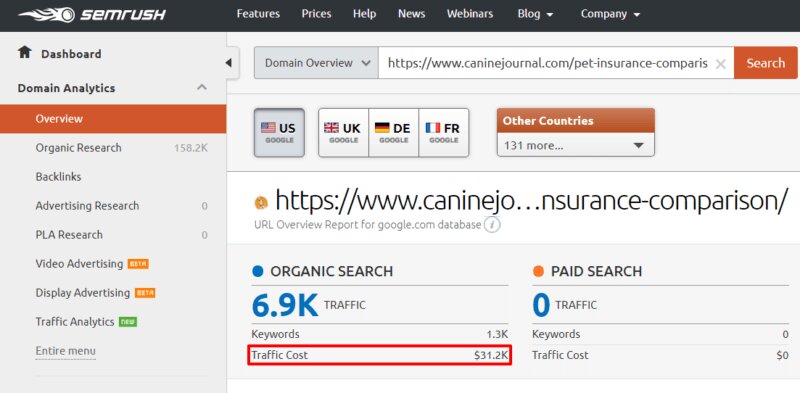
However, it appears that this SERP has a lot of competition, with good results including Canine Journal, Consumers Advocate, Consumer Report, and Nerd Wallet.
To locate something less competitive, I’ll look for [exotic pet insurance], where Nationwide ranks first and has a $2.9K traffic value according to SEMrush:
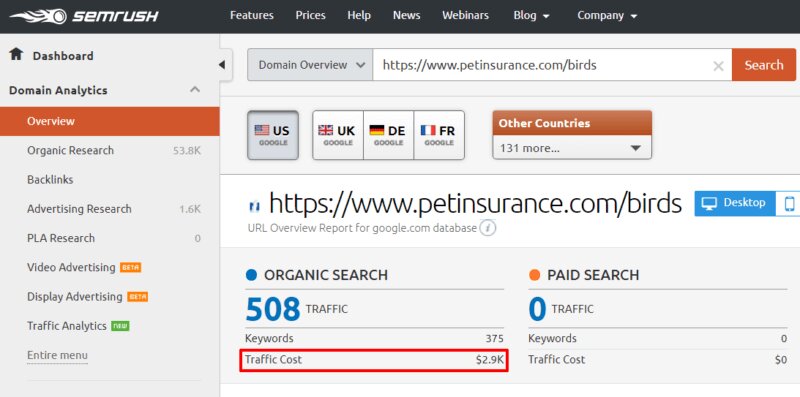
I can see these pages ranking with bad exact-match domains by looking right below the Nationwide result:
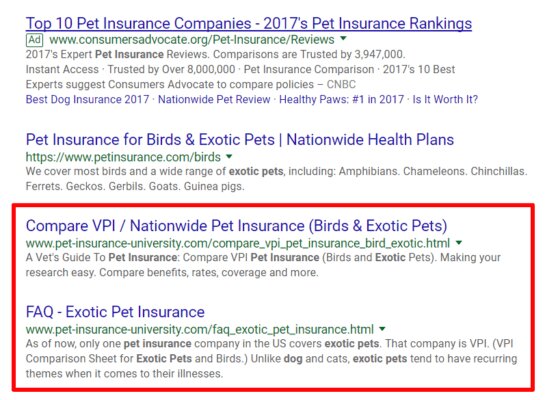
Getting to the page further confirms that this is a bad result:

This is an opportunity to develop material that will better benefit consumers while also having a high probability of ranking.
You may use Moz’s Keyword Explorer tool to obtain an approximation of the competition and complexity around certain keywords and phrases in addition to manually analyzing the search results, but the key takeaway for us was the success we saw from being strategic about the SEO impact of the content we created.
- Leveling up over time
In SEO, momentum is crucial.
As your campaign gains traction, SEO has a multiplier impact, which means your results will grow exponentially. As you get greater search visibility, you start to draw more people — and if you meet their requirements, they’ll keep coming back (growing traffic), endorsing your website (links), and telling others about how amazing you are (social media, blogs, podcasts).
After six months of hard effort, we saw our site was gaining momentum, and we began to raise expectations. We proceeded to target more competitive spaces (which we had avoided at first) and were successful because we had established a strong foundation.
We created a strong foundation of authority and trust with our site, allowing us to compete for higher-value keywords. We proceeded to make even greater bets on the content we generated after seeing early returns, not just investing in original design and photography, but also adding interactive features like bespoke tools and video.
For example, in this screenshot you can see the payoff:

During the summer months of this year, we focused on a very competitive, high-volume topic, and the outcome was additional all-time highs, exceeding our prior statistics by a substantial margin.
Another successful technique was to update and improve outdated content by utilizing “Last Updated” post dates. Small modifications to existing content, whether it was changing copy or adding a video, benefited us in a variety of ways, including providing content freshness, increasing click-through rate (CTR), and demonstrating to readers that the article isn’t outdated.
Brian Dean of Backlinko, for example, uses this approach in the following way:

We saw a substantial traffic increase when we began targeting more competitive phrases and gaining more awareness, surpassing 100,000 visits by the end of month 12.

Wrap-Up:
To increase traffic, we didn’t utilize any tricks or hacks. Rather, we focused on creating high-quality content and implementing a variety of link-building techniques to fit each stage of the project. Our expectations and goals rose with the site’s growth.
To summarise, this is how I increased the traffic:
- Begin slowly and profit from “easy wins.”
- Concentrate on obtaining a handful of strategic links to essential pages.
- To get momentum, create passive link acquisition channels.
- Make content creation and its influence on search a priority.
- Level up your time and seek for higher-value possibilities.
We’ve discovered that this is a repeatable, scalable approach that works. Undoubtedly, you’ll need to modify and adjust this method to meet your own situation and requirements. I do hope, though, that you can use the important lessons we gained from this project for your own strategy.

